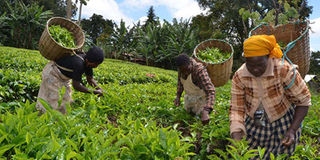Hats off to rural women

Tea picking at Kiangondu village in Tharaka-Nithi County on October 12, 2019. Rural women make a very important contribution to development. October 15 marks the International Day of Rural Women.. PHOTO | ALEX NJERU | NATION MEDIA GROUP
What you need to know:
- Regardless, women and girls in rural areas suffer disproportionately from multi-dimensional poverty.
- While the prevalence of extreme poverty has decreased globally, about 1 billion people in the world continue to live in unacceptable conditions of poverty. These people are heavily concentrated in rural areas.
Rural women make a very important contribution to development. October 15 marks the International Day of Rural Women.
This year’s theme is Rural Women and Girls Building Climate Resilience; in light of the critical need to act against climate change around the globe, with special focus on the role of women and girls in developing mechanisms to face it.
The day, which has been observed annually since October 15, 2008, recognises “the critical role and contribution of rural women, including indigenous women, in enhancing agricultural and rural development, improving food security and eradicating rural poverty.”
In rural areas, women and girls play a crucial role in ensuring the sustainability of their households and communities, actively improving their livelihoods and overall wellbeing.
Women form a majority of the agricultural labour force, including informal work, and are involved in a substantial amount of unpaid care and domestic work within families and households in rural areas.
They make significant contributions to agricultural production, food security and nutrition, land and natural resource management, and building climate resilience.
MULTI-DIMENSIONAL POVERTY
Regardless, women and girls in rural areas suffer disproportionately from multi-dimensional poverty.
While the prevalence of extreme poverty has decreased globally, about 1 billion people in the world continue to live in unacceptable conditions of poverty. These people are heavily concentrated in rural areas.
Rates of poverty in rural areas across most regions are higher than those in urban areas. Yet smallholder agriculture produces nearly 80 per cent of food in Asia and sub-Saharan Africa and supports the livelihoods of some 2.5 billion people.
Women farmers may be as productive and enterprising as their male counterparts, but are less able to access land, credit, agricultural inputs, markets and high-value agro-food chains and obtain lower prices for their crops.
Furthermore, the presence of discriminatory social norms and other structural barriers continue to hamper women’s decision-making power and political participation in rural settings.
They lack equal access to productive resources and assets, public services, such as education and health care, and infrastructure, including water and sanitation, while much of their labour remains nearly invisible and often unpaid, even as their workloads become increasingly heavy due to the urban migration of men.
Around the world, with few exceptions, every gender and development indicator with readily available data reveals that rural women fare worse than rural men and urban women, with special notice to the risk of disproportionate poverty, exclusion and the effects of climate change.
According to the United Nations, one in three employed women works in agriculture globally. 80 per cent of households without piped water rely on women and girls for water collection.
Rural women are often at the forefront of the battle lines when natural resources and agriculture are threatened.
Finally, it is important to note that one of the most effective ways to tackle the threats posed by climate change is by addressing gender inequality.
Empowering women confers a power and capacity that in turn enables them to respond to climate change.
Women have the power to mobilise and educate their communities on climate change, in addition to adopting low-carbon technologies.





